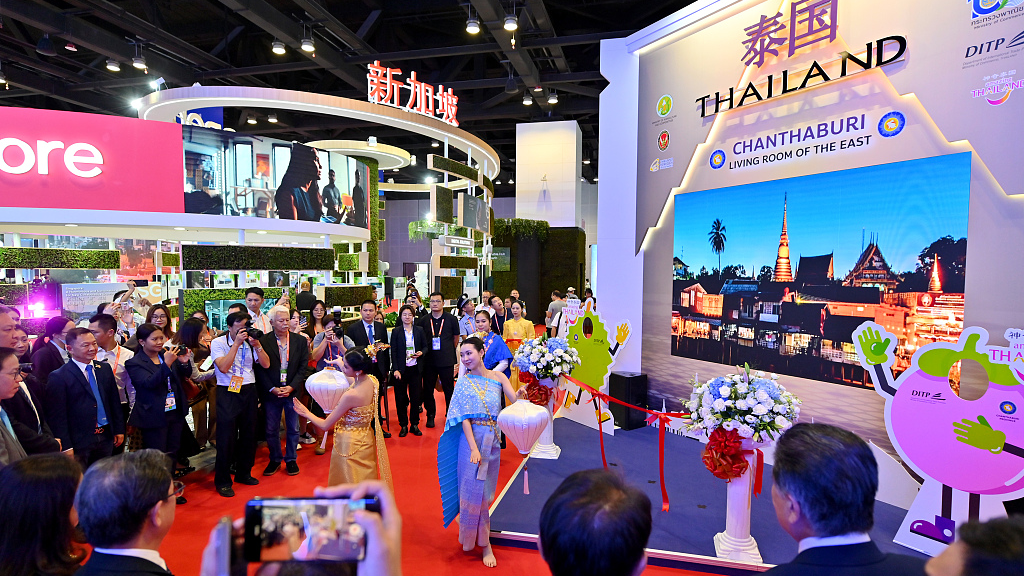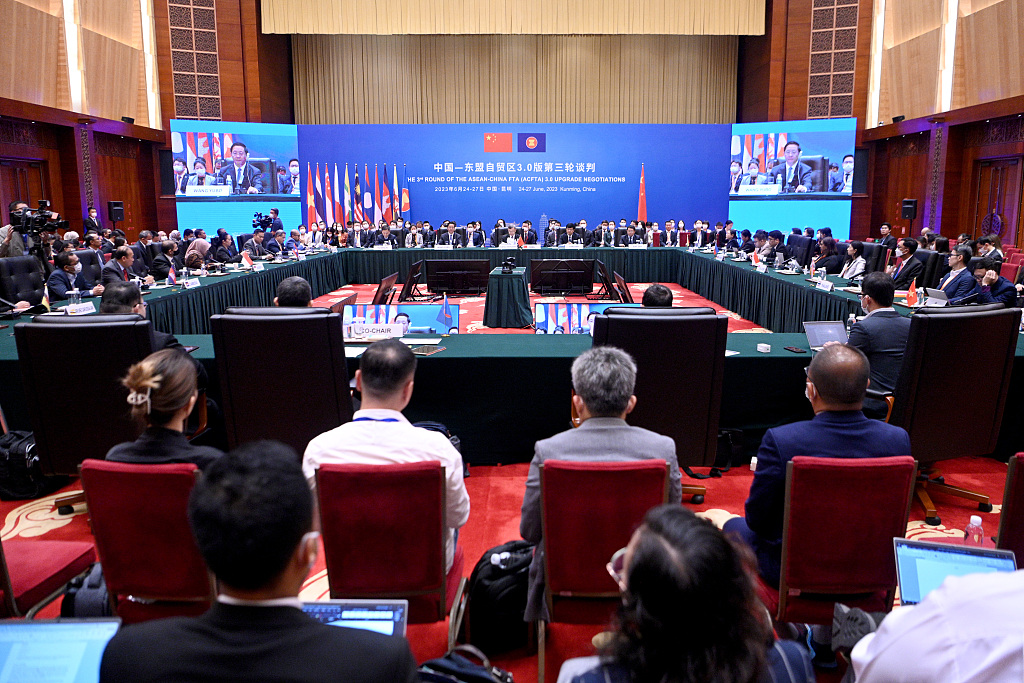
Booths representing Thailand and Singapore are seen at the Nanning International Convention and Exhibition Center during the 20th China-ASEAN Expo, in Nanning, the capital of south China's Guangxi Zhuang Autonomous Region, September 17, 2023. /CFP
Booths representing Thailand and Singapore are seen at the Nanning International Convention and Exhibition Center during the 20th China-ASEAN Expo, in Nanning, the capital of south China's Guangxi Zhuang Autonomous Region, September 17, 2023. /CFP
Editor's note: Imran Khalid, a special commentator on current affairs for CGTN, is a freelance columnist on international affairs. The article reflects the author's opinions and not necessarily the views of CGTN.
The 20th China-ASEAN Expo signifies a path towards deeper cooperation, paving the way for shared development between China and its Association of Southeast Asian Nations (ASEAN) counterparts. Notably, the 19 diverse forums occurring alongside the main event have indirectly propelled negotiations for the Version 3.0 China-ASEAN Free Trade Area (FTA), bringing about added benefits and opportunities for all stakeholders involved.
This expo underscores the collaborative spirit that defines China's role in the region, one that contributes to a shared future. Speaking at the thematic side event of the China-ASEAN Expo, themed "institutional opening-up for new regional economic growth," Chinese Vice Commerce Minister Li Fei reiterated China's commitment to a progressive approach, emphasizing the expansion of institutional openness and stronger collaboration in trade and investment with ASEAN.
While underscoring China's determination to reduce barriers by reasonably trimming the negative list for foreign investment access, Li also expressed China's readiness to collaborate closely with ASEAN to expedite negotiations for the China-ASEAN FTA Version 3.0. This clearly shows that Beijing is committed to the liberalization of trade and investment through various measures. This approach will not only foster regional economic integration but also create a more open and interconnected global economy.
A notable highlight from the thematic side event on September 17 was the establishment of the China-ASEAN standardization cooperation and exchange center. This achievement underscores China's role as a pivotal player in international standardization, offering innovative solutions in emerging fields like new-energy technology and electric vehicles. Strengthening collaboration between China and ASEAN in international standardization holds paramount significance in the contemporary landscape. Institutional opening-up, a focal point of China-ASEAN cooperation, presents abundant opportunities across various industries and sectors.
Proposals put forth by the Chinese Ministry of Commerce are poised to facilitate economic integration, particularly as the United States and its allies are trying to establish a global supply chain that excludes China, relocating industrial chains to Southeast Asia.
Institutional opening-up will serve as a dynamic platform to address a myriad of specific challenges, fostering cooperation between China and ASEAN. This project will not only advance mutual interests but also reinforce China's commitment to a more interconnected and inclusive global economic landscape. In a world marked by shifting dynamics and global realignments, this shared commitment to deeper engagement and integration is expected to shape the future of regional relations.
It is imperative that this institutional opening-up initiative not only exists in theory but also offers tangible benefits to those who operate within it. Engagement with the private sector can provide invaluable recommendations for refining and enhancing the initiative.
In a world fraught with complexities, such thoughtful strategies entail meaningful progress and signify the commitment of China and ASEAN to navigating the evolving global landscape. The eagerly awaited Version 3.0 China-ASEAN FTA promises to delve into deeper cooperation within emerging industries and regional development sectors.

The opening ceremony of the third round of negotiations for the Version 3.0 China-ASEAN Free Trade Area, in Kunming, southwest China's Yunnan Province, June 25, 2023. /CFP
The opening ceremony of the third round of negotiations for the Version 3.0 China-ASEAN Free Trade Area, in Kunming, southwest China's Yunnan Province, June 25, 2023. /CFP
The Version 3.0 FTA blueprint encompasses critical domains, including the digital economy, green economy, and supply chain connectivity. This strategic move dovetails seamlessly with the ongoing construction of the Regional Comprehensive Economic Partnership, attracting investments from multinational corporations beyond the pact's borders. This harmonious convergence of economic forces signifies a brighter future marked by innovation, sustainability, and global cooperation.
The inception of the Version 1.0 China-ASEAN FTA in 2010 marked a decade of dedicated efforts, resulting in zero tariffs on trade in goods covering 90 percent of products in tariff lines. The subsequent implementation of Version 2.0 in 2019 saw an even more open market approach. The recent launch of negotiations for Version 3.0 in November 2022 signifies a continued commitment to fostering economic integration and shared prosperity between China and ASEAN, reflecting the region's dynamic evolution.
The much-anticipated Version 3.0 is likely to chart an ambitious and forward-looking course, delving into the realms of data protection and open data within the digital economy. Simultaneously, the green economy will also take center stage with a spotlight on new-energy vehicles and cutting-edge battery technologies. These forward-thinking initiatives reflect China and ASEAN's mutual recognition of the need to adapt to evolving global dynamics.
As Western competition looms large and industrial overlaps become apparent, the Version 3.0 FTA carries a strategic focus on regional industrial division and development. This approach will not only enhance regional integration but also drive progress through the exchange of personnel and production factors, propelling China and ASEAN towards a future of shared growth and prosperity.
(If you want to contribute and have specific expertise, please contact us at opinions@cgtn.com. Follow @thouse_opinions on Twitter to discover the latest commentaries in the CGTN Opinion Section.)